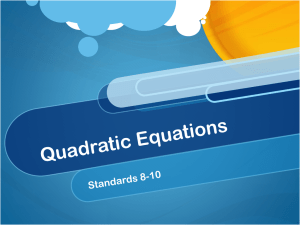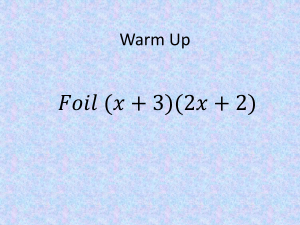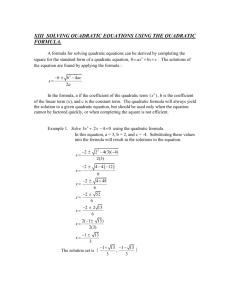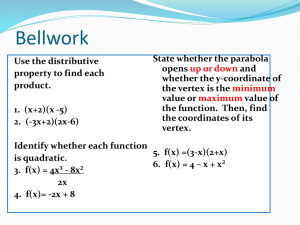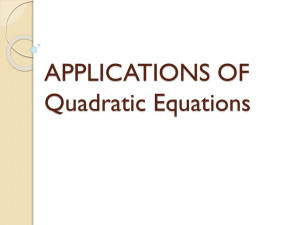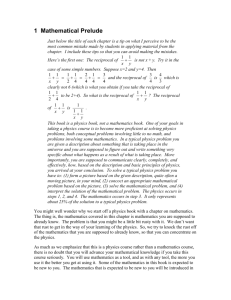The Quadratic Formula
advertisement
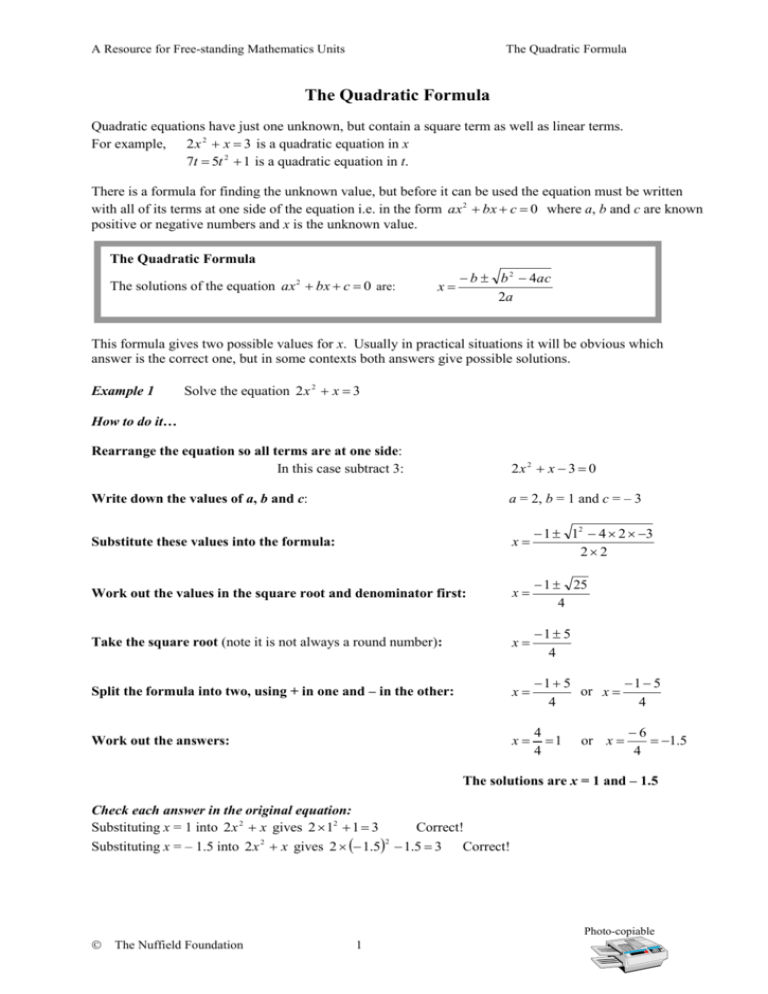
A Resource for Free-standing Mathematics Units The Quadratic Formula The Quadratic Formula Quadratic equations have just one unknown, but contain a square term as well as linear terms. For example, 2 x 2 x 3 is a quadratic equation in x 7t 5t 2 1 is a quadratic equation in t. There is a formula for finding the unknown value, but before it can be used the equation must be written with all of its terms at one side of the equation i.e. in the form ax 2 bx c 0 where a, b and c are known positive or negative numbers and x is the unknown value. The Quadratic Formula The solutions of the equation ax 2 bx c 0 are: x b b 2 4ac 2a This formula gives two possible values for x. Usually in practical situations it will be obvious which answer is the correct one, but in some contexts both answers give possible solutions. Example 1 Solve the equation 2 x 2 x 3 How to do it… Rearrange the equation so all terms are at one side: In this case subtract 3: 2x 2 x 3 0 Write down the values of a, b and c: a = 2, b = 1 and c = – 3 Substitute these values into the formula: x 1 12 4 2 3 2 2 Work out the values in the square root and denominator first: x 1 25 4 Take the square root (note it is not always a round number): x 1 5 4 Split the formula into two, using + in one and – in the other: x 1 5 1 5 or x 4 4 Work out the answers: x 4 1 4 or x 6 1.5 4 The solutions are x = 1 and – 1.5 Check each answer in the original equation: Substituting x = 1 into 2 x 2 x gives 2 12 1 3 Correct! 2 2 Substituting x = – 1.5 into 2 x x gives 2 1.5 1.5 3 Correct! Photo-copiable The Nuffield Foundation 1 A Resource for Free-standing Mathematics Units Example 2 The Quadratic Formula Solve the equation 7t 5t 2 1 How to do it… The working is usually easier if the squared term is positive. Write the equation the other way round: Subtract 7t: 5t 2 1 7t 5t 2 1 7t 0 a = 5, b = – 7 and c = 1 Take care when writing down the values of a, b and c: ––7=7 7 7 2 4 5 1 Substitute these values into the formula: t Work out the values in the square root and denominator: t 7 29 10 When the square root is not exact, round it to about 4 figures: t 7 5.385 10 Split the formula into two: t 7 5.385 7 5.385 or t 10 10 25 12.385 1.615 or t 10 10 The solutions are t = 1.24 and 0.16 (to 2dp) t Work out the answers: Check each answer in the original equation: Substituting t = 1.24 into each side: LHS: RHS 7t 7 1.24 8.68 5t 2 1 5 1.24 2 1 8.688 Substituting t = 0.162 into each side: LHS: RHS 7t 7 0.16 1.12 5t 2 1 5 0.16 2 1 1.128 Near enough! The slight discrepancies are due to rounding. Solve these: 1 x 2 2x 8 2 3 7 x 2x 2 0 3 22t t 2 21 4 t 2 7 6t 5 5x 2 2 9 x 6 6 p 2 5 17 p 7 y2 2y 4 8 2r 2 6r 3 9 3q 2q 2 7 10 20 3r 2 5r 11 12 3t 2 14t 5 5 2x x 2 Photo-copiable The Nuffield Foundation 2 A Resource for Free-standing Mathematics Units The Quadratic Formula Teacher Notes Unit Intermediate Level, Using algebra, functions and graphs Notes This resource includes two examples showing how the quadratic formula can be used to solve quadratic equations together with a set of similar questions for practice. A separate Nuffield resource called ‘Tunnel’ gives examples of quadratic equations in real contexts that can be used when students have become confident with the method. It also shows how problems involving quadratic equations can be solved using graphs in Excel. Answers (to 2 dp when not exact) 1 2, – 4 2 – 0.5, – 3 5 0.2, – 2 6 2.5, 1 3 9 2.77, – 1.27 10 1.88, – 3.55 3 21, 1 7 3.24, – 1.24 11 1.45, – 3.45 4 7, – 1 8 0.44, – 3.44 12 4.28, 0.39 Photo-copiable The Nuffield Foundation 3


